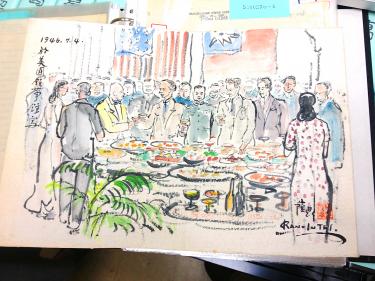Democratic Progressive Party Taipei City councilors were furious yesterday at the Taipei 228 Memorial Museum because a painting of great historic significance by Taiwanese artist Lan Yin-ting (藍蔭鼎) was hidden in an archive and folded in half.
Taipei City Councilor Chien Yu-yen (簡余晏) said this shows that the 228 Memorial Museum is handling the nation’s valuable cultural treasures in a roughshod manner.
The painting was an important period piece by Lan, with portrayals of key government figures at a July 4 reception at the US consulate in Taipei in 1946.
Lan (1903-1979) was born in Yilan County’s Luodong Township (羅東) and went on to become a leading Taiwanese artist, and was once named one of the world’s top 10 watercolor painters by the European Art Critic Society and the American Art Critic Society.
He attended the reception at the US consulate in 1946, and produced the painting, which proved prescient in light of the 228 Massacre eight months later.
Lan portrayed the tension between US diplomatic officials and Chinese Nationalist Party (KMT) military officers who had shortly before taken over the administration of Taiwan.
The painting showed KMT-appointed then-Taiwan governor-general Chen Yi (陳儀) talking to the top US official while then-chief of staff for the Taiwan Garrison Command Ke Yuan-fen (柯遠芬), dressed in his military uniform, stares straight ahead, haughtily ignoring the other figures.
Standing next to Ke is US vice consul George Kerr, who later penned the book Formosa Betrayed, to document his experience of the 228 Massacre events.
Lan gave the painting to Kerr as a gift.
After Kerr’s death in 1992, then-museum director Iap Phok-bun (葉博文) purchased the painting and other 228-related documents from Kerr’s family.
Chien, Taipei City Coucilor Hsu Shu-hua (許淑華) and some others went to the museum yesterday to inspect it.
Chien requested to see this particular painting by Lan, but at first, the staff could not find it.
Museum staff eventually located the painting, but Chien was indignant because it was folded in half and placed in a folder.
“This painting was appraised by experts, who valued it at more than NT$1 million [US$33,000]. It is also a key historic item, documenting an important chapter of Taiwan’s history. Much effort was involved to bring it back to Taiwan,” Chien said. “But we found it folded up and it had sustained some damage. This indicates the museum is handling these valuable items very badly.”
In response, museum director Hsieh Ying-tseng (謝英從) said the painting was folded up when they received it.
However, Chien questioned the explanation, and said even if that were the case, it should not have been folded up and hidden in the archive files.
Source: Taipei Times - 2014/08/20





















